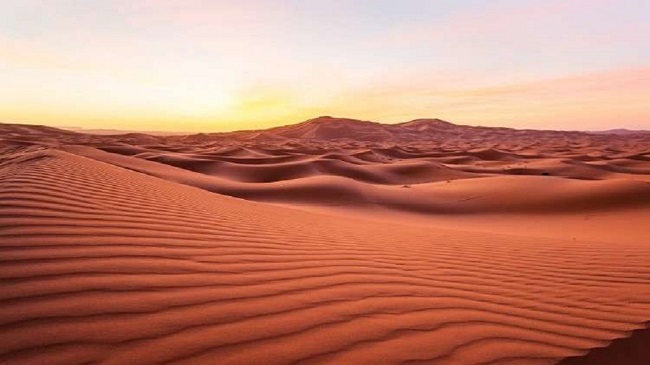Daytime highs in deserts might reach 50 degrees Celsius, but nighttime lows can be much lower. The lack of atmospheric moisture causes this phenomenon.
Particles of sand heat and cool more rapidly than surrounding air. At night, when the Sun is not shining, the sand begins to lose heat.
Because there are so few water molecules in the air (Humidity), the reflected heat from the sand particles also inevitably exits, further cooling the sand.

What Causes the Night time Cold in Deserts?
Those planning a day trip to North Africa’s Sahara Desert should stock up on water and sun protection. However, if you intend to spend the night, don’t forget to pack a warm sleeping bag.
The average daytime temperature in the Sahara is around 38 degrees Celsius, but the temperature can drop to as low as 25 degrees Fahrenheit (minus 4 degrees Celsius) as the sun goes down, as reported by NASA.
So, why can dry regions like the Sahara see such a sudden temperature drop? I am curious as to how the native flora and fauna survive in such severe conditions.
Read Also:
Humidity and Temperature
It is the combination of sand and humidity that causes the extreme heat and cold that characterise arid deserts, which account for around 35% of Earth’s area.
Sand isn’t a great heat-reserving medium, unlike a thermos. According to a 2008 analysis from NASA’s Jet Propulsion Laboratory in Pasadena, California.
Sand grains in a desert’s top layer absorb and release heat back into the air when exposed to the sun’s heat and light.
Extreme heat is generated during the day because the sand absorbs and radiates the sun’s rays, causing the air around it to become extremely hot.
At night, though, the sand and its surroundings cool down because the sun isn’t out to warm it and the heat swiftly dissipates into the air.
Adapting to Extreme Temperatures
Animals native to the desert have evolved to survive the high heat and cold of its seasons.
Since they are ectothermic (meaning they do not need to spend energy maintaining a constant body temperature).
The desert’s most numerous and varied animal group, reptiles, have adapted well to the region’s wide temperature swings.
Their is, the reptiles can put that vitality into more productive pursuits, like catching dinner. Being small is an advantage for many reptiles because it permits them to hide in shaded places during the day and under warmer rocks at night.
DeNardo told Live Science, “There are a lot of different locations to go to be warmer or colder, especially when you’re small.”
Not all Deserts Get Cold at Night
Humidity, clouds, and even wind all play a role in why some deserts get cold at night, despite the common misconception that deserts are always dry.
Actually, it’s not always true that deserts have dry air. In contrast to other deserts, humidity is higher in some places, such as Kuwait and the United Arab Emirates (e.g., some parts of the Sahara desert).
Humid air holds some of the heat generated by the ground, making these deserts warmer at night.
Not All Deserts are Hot
What if I told you that the following is also a picture of a desert, despite the fact that your first mental image upon hearing the word “desert” is likely to be of an unending expanse of land covered with sand?
This is an arctic desert, despite the fact that penguins might not be the first thing that comes to mind when you think of a desert. A desert is defined by its lack of rain and other forms of precipitation (including snow and sleet).
Therefore, Antarctica, which is entirely covered in ice and has average annual temperatures of around -75 degrees Celsius, qualifies as a desert according to this definition.
One of the largest and driest deserts on Earth, it receives relatively little precipitation year-round. Before setting up camp in the desert, it’s a good idea to learn about the local climate.
You wouldn’t want to go through the trouble of bringing along a heavy blanket just to discover that the desert you’re camping in doesn’t get chilly at all.
Read Also:
Conclusion
Sand is a fascinating material. It’s dry but slick, and it doesn’t absorb water well since its particles are larger than those in other soil types.
Deserts are so hot because sand is poor at insulating against the sun’s rays. In deserts, the sand doesn’t retain the sun’s warmth when it’s heated by the sun.
Instead, it reflects the sun’s rays and warms the air above the ground. Forests, beaches, plains, and mountains don’t radiate as much heat to the air above their surfaces as deserts do, thus they don’t get as hot.




